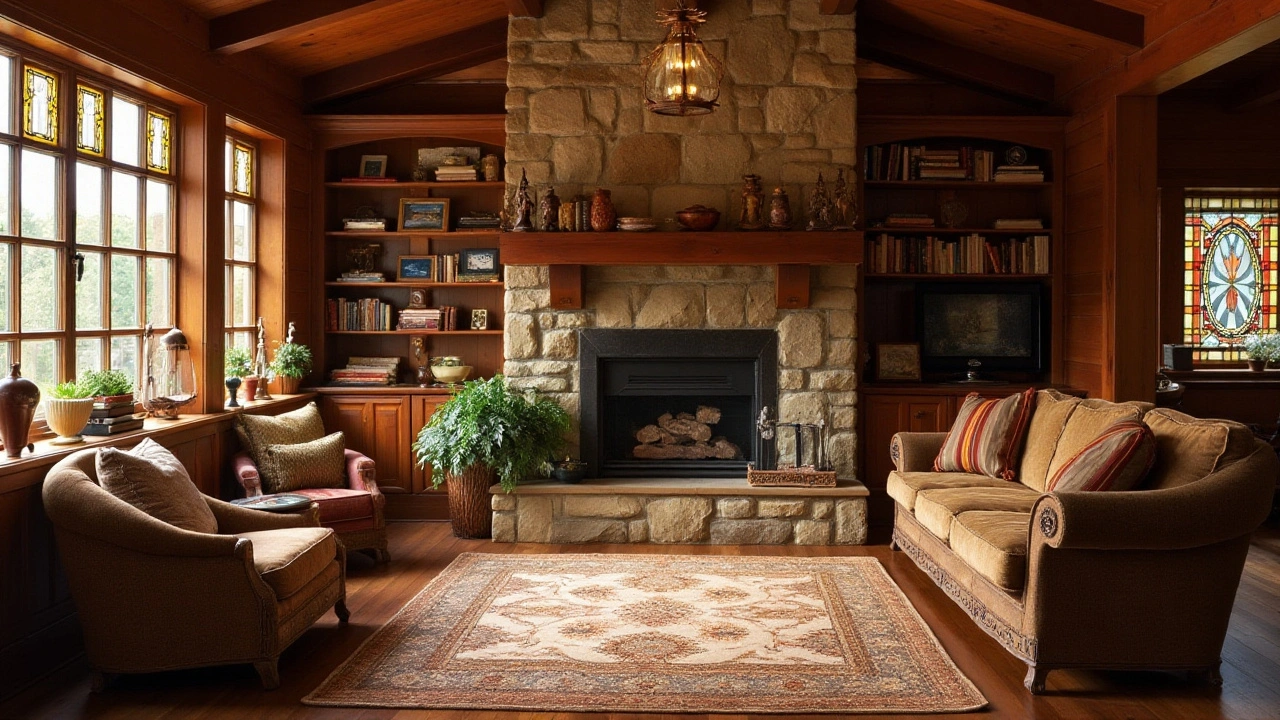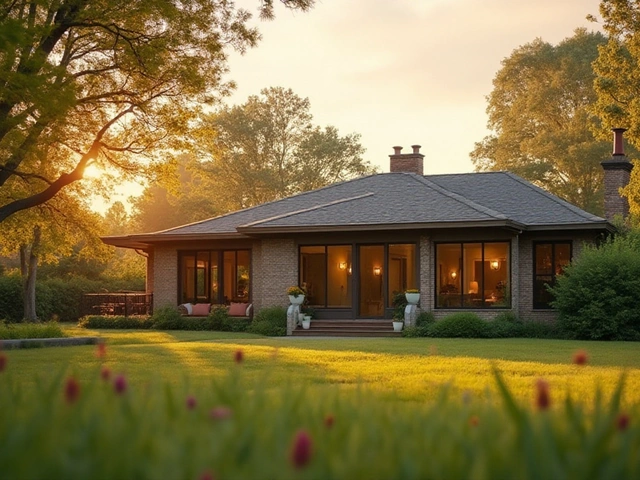Step into an American Craftsman home, and you can instantly feel its warmth and character. This architectural style, which gained popularity in the early 20th century, stands out for its insistence on simplicity and high-quality construction. The Craftsman movement emerged as a reaction against the mass production of the Industrial Revolution, emphasizing handmade work and natural materials.
Originally inspired by the British Arts and Crafts movement, American Craftsman homes focus on functionality and understated beauty. They often feature low-pitched gable roofs, spacious porches, and intricate woodwork, creating inviting spaces that feel both cozy and elegant. These homes radiate a sense of history, filled with built-in elements like bookcases and seating nooks that enhance everyday living.
Craftsman design continues to influence modern architecture and interior design, with many seeking to incorporate its distinctive elements into contemporary spaces. Its timeless appeal lies in the seamless blend of structure and artistry, making each Craftsman home a testament to the skill and vision of its creators.
- Origins and Philosophy
- Key Architectural Features
- Craftsmanship and Materials
- Influence on Modern Design
- Tips for Incorporating Craftsman Style
Origins and Philosophy
The American Craftsman movement traces its roots back to the late 19th and early 20th centuries, growing out of the British Arts and Crafts movement. This significant architectural style arose as a direct response to the rigid and ornate details of the Victorian era and the soullessness of industrial production methods that dominated the time. Craftsman architecture advocated for simplicity, honesty of materials, and the visibility of hand craftsmanship. Guided by a thoughtful philosophy, it celebrated the beauty found in authenticity, labor, and nature, rather than the mass-produced sameness that was prevalent.
An intriguing chapter in the Craftsman story unfurls during the late 1800s, when visionary designers and social reformers like William Morris in England began promoting a return to simpler, more functional designs, in contrast to elaborate and excessive decorative styles. Morris believed that art lives in the everyday crafts produced by skilled hands, and this philosophy of making art accessible to all strata of society significantly influenced Craftsman ideals in the United States. An emphasis on artisanship over industrial labor found fertile ground in the creativity and democratic spirit of America. Among those influenced were the Greene brothers, Charles Sumner Greene and Henry Mather Greene, who became renowned for their stunning designs that epitomized the Craftsman movement.
A key highlight of the movement's history in the United States is the advent of Craftsman houses, which offered a more personal, inviting, and equalizing form of home for the burgeoning middle class. This goes hand in hand with Gustav Stickley, a pivotal figure whose magazine, "The Craftsman," helped popularize the styles and techniques that defined this revolution in design. Stickley, who published plans and even offered mail-order home kits, worked tirelessly to make such homes accessible and affordable for average Americans. His passionate writings emphasized the profound connections between one's living environment and well-being, with famous declarations like, "The object of the home must be the expression of the lives within it."
The philosophical backbone of Craftsman architecture lies deeply in its commitment to elevating how people experience their daily environments. It sought to create spaces that were not only utilitarian but also uplifted residents by fostering a sense of harmony and connection with nature. Homes were designed to blur the lines between indoor and outdoor spaces, with broad, welcoming porches and expansive windows that brought natural light and picturesque views inside. This made them environments where nature was not just an ornamental accessory but played an integral role in design and lifestyle. This holistic approach encouraged mindfulness, offering sanctuary and respite in an increasingly industrialized world.
Rich in its appreciation for handcrafted art, this movement criticizes the lack of individuality and creative input in factory-produced goods. Craftsman architecture isn't just a set of rules; it's a testament to an enduring belief in the power of the human touch. The respect for materials—whether wood, stone, or stained glass—highlights a mindful application of resources and a sustainable approach to building which is respected by today's architects seeking eco-friendly methods. By valuing what is simple and functional, the Craftsman style continues to teach that beauty is not found in excess but in the thoughtful execution of every detail, a lesson more pertinent than ever as we move through modern design challenges.
Key Architectural Features
Walking into an American Craftsman home immediately offers a feast for the eyes with its distinctive architectural details that are both inviting and comforting. One of the first things you'll notice is the roof, typically low-pitched with wide eaves and triangular brackets, giving the home a grounded appearance while also providing sheltering overhangs. These rooflines not only serve an aesthetic purpose but also function to protect the house from the elements, a clever combination of form and function that defines the style.
As you explore further, the presence of a spacious front porch becomes evident, often supported by sturdy columns. The extensive use of natural materials like wood and stone in columns and trimming brings a piece of nature right into urban and suburban landscapes. This connection with nature is a hallmark of Craftsman design, with many homes showcasing locally-sourced materials that lend each structure a unique regional flavor.
Inside, the attention to craftsmanship becomes even more apparent. Rooms are often an open plan, encouraging ease of movement and interaction, yet they are distinctively defined through the use of wood detailing such as wainscoting, crown moldings, and exposed beam ceilings. These architectural features not only serve a practical purpose but also elevate the overall visual appeal of the interior space. The integration of built-in furniture such as bookcases and benches is another brilliant aspect, offering both style and practicality, a testament to how Craftsman homes tirelessly celebrate craftsmanship.
According to Charles and Henry Greene, prominent architects of the Craftsman movement, "Architecture should be honest and express the beauty inherent in the structure's materials." This philosophy is echoed throughout the Craftsman style, where the integrity of materials and construction is always a priority.
The large, central fireplace anchors the living space, often designed with intricate tiling or handcrafted stonework, creating a cozy gathering spot. Windows are usually double-hung with many small panes, maximizing natural light, and framed with artisanal detailing. Glasswork, including stained glass elements, often features geometric patterns or earthy motifs, adding an artistic touch that reflects the style's artistic roots.
To further exemplify the Craftsman style's commitment to quality and artistry, look at the thoughtful use of hardwood floors that enhance the warmth and durability of these homes. It's common to find original woodwork, meticulously restored when necessary to preserve its original charm. Wrapping up the incredible craftsmanship that defines this style are these lasting impressions of quality and harmonious design that make Craftsman homes timeless treasures cherished by those who inhabit them.

Craftsmanship and Materials
The defining characteristic of the American Craftsman style lies in its devotion to exceptional craftsmanship and select materials. Craftsman homes honor traditional building techniques, often featuring hand-hewn woodwork, custom cabinets, and bespoke furniture that harmonize both in form and function. This was a reaction to the prevailing machine-driven economy of the time, which valued quantity over quality. American Craftsman architecture showcases details that exude genuine artistry, distinguishing these homes from their mass-produced counterparts.
In many instances, the materials used are sourced locally, emphasizing a connection with the environment. The use of enduring materials like oak, maple, stone, clay, and metal provides not just structural integrity but also aesthetic warmth and texture. Stone is frequently employed in the construction of sturdy fireplaces and porch columns, forming a grounding presence in homes. This style often incorporates natural finishes, using stains that highlight the rich grains of the wood rather than hiding them beneath thick layers of paint.
Attention to detail is paramount in the Craftsman tradition. Carpenters painstakingly detail each piece to ensure harmony within the home, creating a seamless and unified look. Decorative elements, such as stained glass windows and detailed wood trim, infuse homes with character while maintaining functionality. These elements are often handcrafted, making them unique to each dwelling and demonstrating the skilled artisanship intrinsic to this style.
The emphasis on practicality is also evident in the design choices found within Craftsman homes. Built-in features such as bookcases, benches, and breakfast nooks provide utility without compromising the aesthetic. Many homes also boast wide overhanging eaves and exposed rafters, providing shelter while adding architectural interest. The choice of using exposed beams often reflects the underlying framework of the home, celebrating the honest expression of materials.
The following table illustrates the common materials and their typical uses in Craftsman homes:
| Material | Typical Use |
|---|---|
| Wood (Oak, Maple) | Flooring, Furniture, Cabinets |
| Stone | Fireplaces, Columns, Accent Walls |
| Clay | Roof Tiles, Chimneys |
According to Charles R. Morris, a renowned historian, "The Craftsman style resonates with those who appreciate the beauty and legitimacy of well-made, practical architecture." This appreciation has endured for generations, and its principles continue to be reflected in modern homes. The timeless appeal of these homes, combined with the exquisite craft seen in each element, continues to attract those seeking authenticity in design. It's a testament to an era where craftsmanship was celebrated and remains a revered aspect of architectural design today.
Influence on Modern Design
The American Craftsman style, emerging over a century ago, continues to cast a long shadow on the world of modern design. Rooted in simplicity and authenticity, this architectural approach has proven its timeless nature by continuously influencing contemporary aesthetics. Today's designers often look back to the early 20th-century designs for inspiration, incorporating elements that reflect the honesty and integrity of traditional craftsmanship.
One profound way the Craftsman style impacts modern design is through its emphasis on natural materials. While synthetic options abound, many architects and builders prefer wood, stone, and other authentic materials that echo the original commitment to nature. Modern homes often showcase exposed wooden beams, stone fireplaces, and hand-crafted details that harken back to the original Craftsman ethos, adding warmth and a personal touch to otherwise streamlined spaces.
Incorporating this style isn't just about materials. The essence of American Craftsman design includes a thoughtful blend of form and function, which is a principle that modern minimalist designs often embrace. Whereas minimalism can sometimes feel cold and impersonal, the balance with Craftsman features can create an inviting space full of character and life. This is a real testament to the enduring wisdom behind this design philosophy.
“The ideal home is one in which the work of the craftsman predominates.” – Gustav Stickley, a notable figure in the Craftsman movement.
Open floor plans, now popular in modern homes, also owe a nod to the Craftsman style. Originally designed to maximize family interaction, Craftsman homes often featured spaces that flowed into one another, eliminating unnecessary barriers. This continuity remains prevalent today, as open-plan designs have become a staple in creating breathable, interconnected living environments.
Moreover, the trend of integrating built-in furniture continues to admire the past. Many modern homes incorporate built-in shelving, seating, and storage areas, reducing clutter and creating an organized look that feels both practical and elegant. It's a surefire way to integrate the Craftsman penchant for optimizing space, making it a harmonious blend of beauty and utility.
Both inside and out, Craftsman details are making a comeback. From tapered columns and wide porches to thoughtfully designed interiors that celebrate handmade qualities, these aspects of Craftsman design imbue a sense of durability and tradition. For those eager to blend nostalgia with modernity, these features provide an excellent blueprint.
The timeless appeal of the Craftsman style not only offers a strategic advantage for those in the home design business but also provides a way for homeowners to connect with their dwellings on a more personal level. By reviving the spirit of the American Craftsman tradition, the built environment becomes a rich tapestry that harmonizes past and present.

Tips for Incorporating Craftsman Style
The timeless allure of the American Craftsman design lies in its focus on simplicity, utility, and the beauty of natural materials. Embracing this style in your own home can bring warmth and character to your living space. To start, pay attention to the authentic use of materials. Quality is key, so choose wood, stone, and even handcrafted tile for flooring or wall applications. This nod to craftsmanship isn’t just about aesthetics; it’s about an appreciation for the art of building. Highlighting exposed wood beams in ceilings or opting for wooden trim can add depth and texture, creating that unmistakable Craftsman coziness. Home style in this tradition isn’t about perfection, but character.
An inviting feature of Craftsman homes is their extensive use of built-in furnishings. To incorporate this hallmark, consider integrated shelving, window seats, or even built-in benches in dining areas. These elements not only save space but also enhance the functionality of your home. Handcrafted furniture pieces, such as mission-style tables or Stickley designs, fit seamlessly into this decor. Their solid wood frames and earthy finishes harmonize beautifully with a Craftsman setting. If you have a fireplace, make it the room's focal point by selecting beautiful, glazed tiles or natural stone surrounds. Maintain a close connection to nature; use earthy color palettes and allow for substantial natural light, tied to the design ethos.
Lighting is an often-overlooked aspect yet plays a significant role in capturing the Craftsman essence. Choose fixtures that feature wrought iron or art glass, resembling the works of Tiffany lamps or prairie-style designs. Look for lamps with geometric shapes and warm, diffused lighting, enhancing a room's ambiance. It's all about subtlety and intimacy in a space. When considering exterior adjustments, a classic Craftsman porch can do wonders. A significant feature, this outdoor space serves as a bridge between nature and indoors. It's a welcoming spot to unwind, encouraging a lifestyle grounded in simple pleasures.
For those wanting an accurate representation, pairing contrasting textures can elevate Craftsman aesthetics. Think about the juxtaposition of brick alongside woodwork or stone, creating harmony by contrast. Some homes even incorporate decorative brackets or gable details, showcasing a mastery in carpentry. As architecture and design enthusiasts assert, authenticity speaks volumes. ‘The Craftsman home is an architectural translation of a lifestyle’,” acclaimed architect Gustav Stickley believed. His words resonate, underscoring the home as a space reflecting personal ethos and simplicity-driven functionality. Craftsman home decor doesn’t chase trends; it cultivates a timeless space of peace and tranquility for years to come.





